In an analog surround sound processor circuit, an operational amplifier is used to create an adder that generates the center channel and left/right channel signals. These adders are connected to the non-inverting and inverting inputs of the op-amp respectively. But how exactly do they perform the addition?
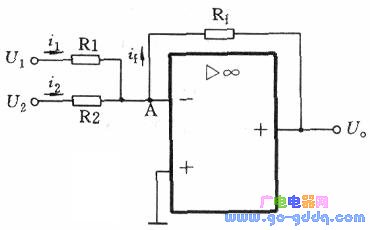
Let's start by analyzing the inverting adder circuit (above). There are two input signals, U1 and U2, which are connected to the inverting input of the operational amplifier through resistors R1 and R2. As you know, point A is considered a "virtual ground," meaning its voltage is approximately zero. The ideal op-amp has infinite input resistance, so the current flowing into the op-amp is negligible. Therefore, the total current i = i1 + i2. Applying Ohm’s Law, we can write: -Uo/Rf = U1/R1 + U2/R2. If Rf = R1 = R2, then Uo = -(U1 + U2). After passing through an inverter, this becomes Uo = U1 + U2, showing that the output is the sum of the two input signals. This principle can be extended to more than two inputs, allowing for Uo = U1 + U2 + ... + Un.
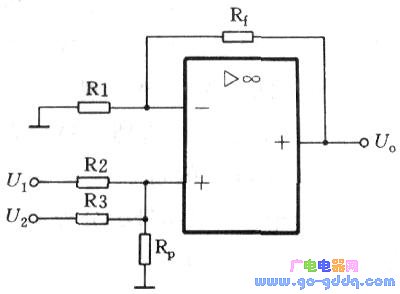
The in-phase adder works on a similar principle but with a different configuration. It uses the non-inverting input of the op-amp, resulting in a sum that maintains the same phase as the input signals.
Now let's look at the subtractor circuit (below). It's also quite straightforward. The idea is to subtract one signal from another using the properties of op-amps.
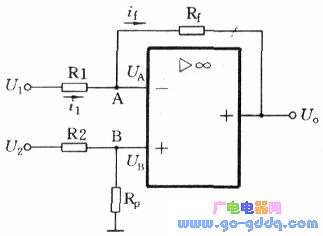
To simplify the analysis, let's assume R1 = Rf = R2 = Rp. Then we calculate UA and UB separately and determine what U1 - U2 equals. This method is effective for understanding the operation of the subtractor.
Derivation process: Since I- = I+ = 0, the current iI = if. So (U1 - UA)/R1 = (UA - Uo)/Rf. Solving this gives UA = ½(U1 + Uo). Similarly, for UB, we get UB = ½U2. Because point A is a virtual short, UA = UB. Substituting, we find that Uo = U2 - U1. Thus, the output is the difference between the two input signals, implementing a subtraction function.
The voltage follower is a special case of the non-inverting amplifier where the output voltage matches the input voltage in both magnitude and phase, giving a closed-loop voltage gain of Af = 1.
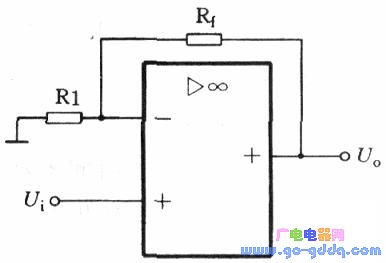
To calculate the closed-loop voltage gain of a non-inverting amplifier, we use Af = Rf/R1 + 1. When Rf/R1 = 0, Af = 1. One way to achieve this is by making R1 = ∞, effectively removing it from the circuit (as shown below).
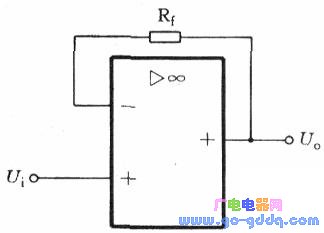
Another way is to set R1 = ∞ and Rf = 0, which means disconnecting R1 and shorting Rf (as shown below). This type of buffer is commonly used in surround sound processors.
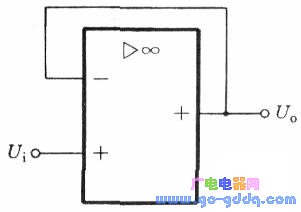
XPON (Passive Optical Network) technology encompasses various types of Optical Network Units (ONUs), each designed to meet specific needs and applications. Here are the different types of XPON ONUs, based on the underlying standards and use cases:
- GPON ONU (Gigabit Passive Optical Network): Designed to operate within GPON networks, which provide high-speed data transmission, typically up to 2.5 Gbps downstream and 1.25 Gbps upstream.
- EPON ONU (Ethernet Passive Optical Network): Based on Ethernet standards, EPON ONUs provide data transmission using Ethernet packets. They typically support speeds of up to 1 Gbps.
- XGS-PON ONU (10 Gigabit Symmetric Passive Optical Network), 10G PON ONT: It supports symmetrical data rates of 10 Gbps both upstream and downstream, making it suitable for high-bandwidth applications. It is suitable for enterprise applications, high-definition video streaming, and other data-intensive services.
- Multi-Service ONU: Capable of delivering various services (internet, voice, video) through a single ONU platform. We have Data ONU , CATV ONU , VOIP ONU , WiFi 4 ONU, WiFi 5 ONU, WiFi 6 ONU. It is used in both residential and commercial environments where multiple services are provided to end-users.
The choice of an ONU type depends on various factors such as service requirements, deployment environment, and the specific standards of the optical network. Each type of ONU is designed to optimize performance, reliability, and service delivery according to its intended use case.
gepon onu,xpon ont,gpon ont,epon onu,dual band wifi onu
Shenzhen Runtop Technology Co.LTD , https://www.runtoptech.com